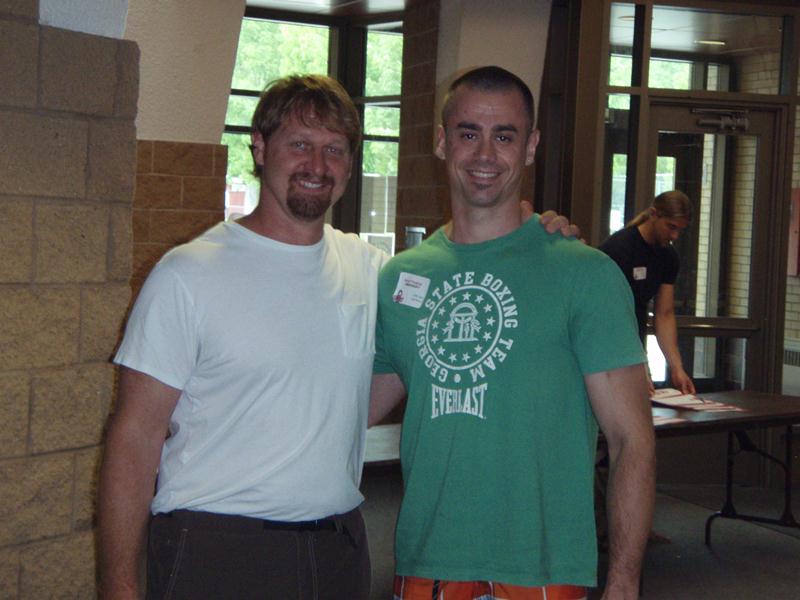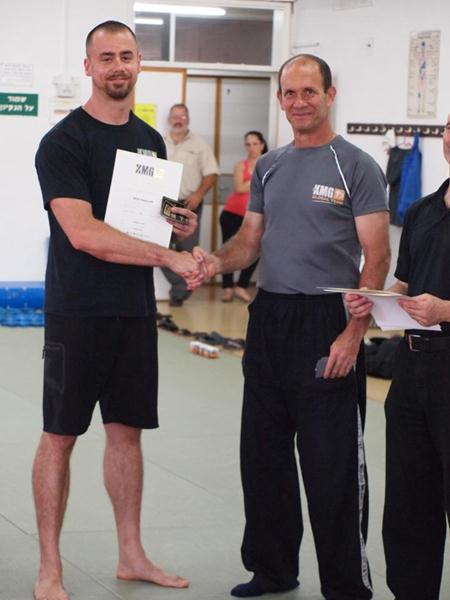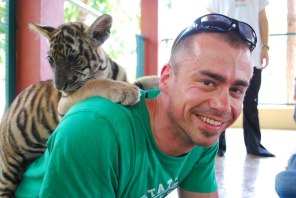Matt With Australian WBC Superfeatherweight Champ Bryan Hasse
Dragon Door: How did you first discover kettlebells?
Matt Beecroft: I was introduced to them in 2003 by my friend Gary, who was a wrestler.
Dragon Door: Were you competing or participating in wrestling at the time?
Matt Beecroft: No, but we were both training in Krav Maga. I was also training stand up striking in Muay Thai, while my friend Gary tended to gravitate towards wrestling and Brazilian jujitsu. So we would regularly go to the gym and train together. One day he gave me this funny looking cannon ball with some handles on it. We tried a few exercises with it together and from that point, I was hooked.
Dragon Door: How did you decide to get your RKC certification?
Matt Beecroft: That’s a good question. I began to buy books and DVDs from Dragon Door and started researching and interacting with people on the Internet. Back then in Australia, there were only two or three RKC instructors scattered around the country. So, I had no one to train with at first.
In 2008, the IKMF—the International Krav Maga Federation—was run by Eyal Yanilov. He's now the worldwide chief instructor for Krav Maga Global of which I am now an Expert Level instructor. The IKMF ran a special RKC for Krav Maga instructors worldwide, organized by Peter Lakatos in Budapest, Hungary. On a whim I jumped on a plane for 28 hours from Australia and did the RKC workshop without any formal training. Even though I had been training at home on my own with books and DVDs, it was really dumb in hindsight. I'd been playing kettlebells for a couple of years, but I wish I could have been a lot better prepared than I was at the time.

Matt with Gray Cook
Dragon Door: What was one of the biggest surprises for you at the RKC?
Matt Beecroft: The scope of the workshop, how it was organized, and how smoothly it was run—it was a large certification workshop. The team leaders were Doc Cheng and Kenneth Jay. Kenneth Jay led my team, he was really relaxed but phenomenally strong and a very good coach. Pavel was there teaching and troubleshooting—it was really cool. Overall, the standard of teaching was very high. And the vibe and culture of the RKC was really addictive.
Dragon Door: How long have you been practicing martial arts?
Matt Beecroft: I had an abusive parent and I was bullied a lot as a kid, so I got into Japanese jujitsu in my early teens. Realistically, I started full time in 1998 when I became certified for fitness and sports coaching. The sports coaching was actually martial arts coaching for wing chun. That certification program was a government accredited, full-time study course.
Dragon Door: Are you training and coaching full-time now?
Matt Beecroft: Yes. I started my personal training business back in 2005. It all started off as a hobby with martial arts and kettlebells, then a couple guys suggested hiring a place up the road so I could teach them. The business grew from there.
Just last year I stepped away from my role as personal training manager for World Gym. For about five or six years, I managed PT’s and teams of ten to fifteen trainers. Now I am focusing on my own team.
It’s been an interesting journey. I started off in the martial arts and self-defense industry by teaching a lot of classes and one-on-one sessions. Eventually, I started getting into mobility, flexibility, and bodyweight training. This led me towards a commercial gym environment and the bodybuilding model. Next, I looked at smarter ways of training in regards to movement, kettlebells, and getting strong.

Matt With Eyal Yanilov, KMG
Dragon Door: Who typically trains with you now?
Matt Beecroft: It's a big mix, I train an eighty-four year old with Parkinson’s, guys who are prepping to fight in the ring, and everyone in between. Lawyers, dentists, professionals, trainers—it's a big cross-section. We run classes Monday night, Tuesday morning, Wednesday morning, Thursday morning, Thursday night, and Saturday morning. I teach small groups and a lot of one on ones in between.

Dragon Door: When you were announced as a Team Leader, your announcement had a photo of you with a baby tiger on your back. What's the story behind that picture?
Matt Beecroft: I was at Tiger Kingdom in Chang Mai, Thailand. Muay Thai is one of my passions, and we also train fighters—some of whom have won Australian Titles. Tiger Kingdom is where you can spend some quality time with tigers. I’ve been to Thailand a few times, and Muay Thai is their national sport. I love the people, the culture, and of course, the sport. So, when I get an opportunity to go there for a couple of weeks, I take it!
Dragon Door: Have kettlebells helped with your martial arts practice?
Matt Beecroft: Most definitely. In Australia, fitness is usually built on a bodybuilding model. What attracted me to kettlebells was the difference in the center of gravity, and the fact that it sits on the outside of the forearm which is great for shoulders. More importantly, the RKC teaches an intelligent way to use the kettlebell.
The kettlebell is an amazing tool, but what grabbed me was the leadership, coaching, and the system of the RKC that surrounds the kettlebell. The RKC is teaching genuine, functional movement. In regards to performance for martial arts, MMA, and defensive tactics training, I found there to be a really cool crossover with kettlebells.
Dragon Door: What’s your favorite kettlebell exercise?
Matt Beecroft: I think it changes depending on the program I’m following. Right now, my favorite overall exercise is a handstand. I am playing around with handstands to improve my pressing strength. And I would have to say loaded backwards leopard crawling. But, I have a real love and hate relationship with the kettlebell get-up. What I like the most about the get-up is how it really highlights individual movements and shows how you are moving on any given day. So, it might highlight how your hips, and T-spine are or are not moving well. The get-up will also show whether your rolling patterns are good or how well your stabilizers are doing their job.
I think the get-up is my favorite. There’s so much going on with the get-up that it’s both a positive and negative thing. The get-up works on so many potential issues, but it also highlights the way you are improving your overall movement. It’s a real bittersweet relationship.
Dragon Door: What are your current training goals?
Matt Beecroft: I’m going to have a crack at the Beast Tamer at the upcoming RKC II in Australia. I’ve been working towards the Beast Tamer for a while now. I’ve had a few niggling injuries that have come up from time to time which aren't due to kettlebells, actually. They're some chronic injuries from my martial arts training that I am working around. So my fingers are crossed that my body holds together, because my goal is to own the Beast.
Dragon Door: Very cool, that’s a big goal! Of the required 48kg pistol, press, and pull up, which lift is the most difficult for you?
Matt Beecroft: I'd say it's the pull-up. I am a tall guy at 6’ 3" and 93kg (205lbs), so I’ve got a long way to pull. I think the Beast Tamer is actually designed so that one of those lifts will get you, regardless of your build. If you're a typical weightlifter and are short and stocky, I think that some of the lifts will favor your body type. When you are tall and lanky like I am, I reckon that none of the lifts are in my favor! I just seem to have a longer way to pull and press, and a longer drop down into a pistol! But, the pull-up is the most challenging for me.
Dragon Door: What do you feel like you'll bring to the RKC as a Team Leader?
Matt Beecroft: Mostly, I think I’m really keen on seeing the RKC evolve to the next level. I think continual refinement and continual improvement is very important, so if I can contribute to that process in a big or small way, then fantastic. But I think for me, the biggest thing is my passion for movement, and helping other people improve their movement, mobility, and their strength.
I've had so much fun experiencing the process myself while training and going through the certifications. And if I can get the same message to other people so that they reap the same benefits, then I’ll be happy. But personally, I just want to contribute to the leadership team in any way, shape, or form. It is really cool to have this opportunity. I hope the RKC continues to get better and better while continuing to build it's good reputation. Dragon Door's RKC is without a doubt the leading kettlebell certification in the world. It's fantastic to be a part of maintaining that reputation along with the quality, and integrity of the RKC and Dragon Door.
Dragon Door: What’s next for your business?
Matt Beecroft: Just continuing to see our people get better. My real goal is to help my clients improve and to coach more people towards hitting their personal bests. I want to help them start to look better too. I see my role as a coach as really investing my time and effort in other people—and hopefully improving my own practice along the way.
In regards to the master plan for the business, if I see some steady growth within the business, then fantastic. We already have great membership numbers and our classes are fantastic. But at the end of the day, it’s really just about me helping other people improve. That’s how I see my role as a coach.
Dragon Door: Can you describe your approach to group classes?
Matt Beecroft: Because I’m also a Primal Move Fundamentals Instructor, we incorporate a lot of Primal Move material for the first half of our one hour and 1 ¼ hour classes. The first thirty minutes usually revolves around a lot of rocking, crawling, rolling, and some of the Becoming Bulletproof material as well. Our classes are quite structured, and we really try to get people moving very well. We always do some skill work in our classes, and there's usually a specific focus for the session. Then from there, we definitely work on kettlebell grinds for our strength work, and some ballistic exercises at the end. The ballistics might be simple, conditioning work such as 100 to 200 swings, high pulls, or snatches—just as long as we get our conditioning in!.
Dragon Door: Sounds like a solid class! Thanks so much for giving us some of your time for an interview.

RKC Team Leader Matt Beecroft: